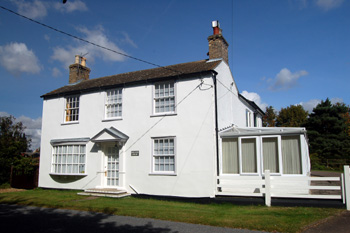The Swan Public House Colmworth

Holland House September 2009
The Swan Public House [also The Old White Swan]: Honeydon Road, Colmworth
It is difficult to trace the early history of this beerhouse from records held by Bedfordshire & Luton Archives & Records Service because of the fragmentary nature of our holdings. It seems that the first mention of it is probably in the will of John Fensham of 1758, proved in 1765, in which he devised a cottage to his son John, who then conveyed it to Cornelius Nicholls of St.Albans in 1770. Nicholls left all his real estate to trustees for sale, which presumably took place shortly after his death in 1789. This packet of documents was identified on the front with a note indicating that they related to the Swan at Colmworth, otherwise there is nothing to link them with the public house.
The first mention of the Swan by name occurs in 1809 when Solomon Safford devised it to his wife Ann in his will. She then devised it equally to her four sons Thomas, John, William and James in 1812. By 1832 John Wagstaff was owner of the Swan. How he obtained it is impossible to say for sure but it seems possible that Thomas Safford bought his brothers out as Bedfordshire & Luton Archives & Records Service has a fine of 1822 noting the sale of two cottages by him to a William Woodcock Hayward, this would mean that Hayward must have conveyed the Swan to Wagstaff at some point between 1822 and 1832 but this must remain conjecture as no such documents seem to have survived.
Wagstaff conveyed the Swan to John Elliott in 1832 and two years later he conveyed it to Bedford brewer John Hill Day. Day purchased a brewery at Saint Neots [Huntingdonshire] in 1840 and in that same year conveyed the Swan to Biggleswade brewers William Hogg and Robert Lindsell who ran the firm that would be known as Wells & Company. This firm was purchased in 1899 by Kent businessman George Winch for his son Edward Bluett Winch and the firm's name changed to Wells & Winch to reflect this. Wells & Winch merged with Suffolk brewers Greene King in 1961, taking that company's name (as Greene King (Biggleswade) Limited) in 1963. The beerhouse closed at some point in the latter half of the 20th century.
The Rating and Valuation Act 1926 specified that every building and piece of land in the country was to be assessed to determine the rates to be paid on it. Colmworth, like most of the rest of Bedfordshire, was valued in 1927 and the valuer visiting the Old White Swan, as it was then called, noted that, it was a detached property, of brick and slate construction with a tap room ("fair"), living room and kitchen downstairs and three bedrooms above. Outside were a stable for two horses, a store shed, pig sty, cart lodge, coal and wood shed. Adjoining and occupied with the beerhouse was 0.7 of an acre of grassland. Trade was hardly brisk - about ten gallons of beer and two dozen bottles of beer in a week. To judge by entries in Kelly's Directories at some point between 1931 and 1936 the beerhouse became a fully licensed public house Today [2009] the former public house is a private and is called Holland House.
References:
- WG42: copy will of John Fensham of Colmworth: 1758 proved 1765;
- WG40-1: conveyance of cottage in Church End from John Fensham, late of St.Albans [Hertfordshire], now of London to Cornelius Nicholls of St.Albans, painter after auction sale: 1770;
- WG43: copy will of Cornelius Nicholls of St.Albans, auctioneer: 1787 proved 1789
- ABP/W1809/3: will of Solomon Safford devising Swan to his wife Ann: 1809;
- ABP/W1812/50: will of Ann Safford devising Swan equally to her four sons Thomas, John, William and James: 1812;
- CLP13: Register of Alehouse Recognizances: 1822-1828;
- HF40/2/11/1: copy fine from Thomas Safford to William Woodock Hayward: 1822;
- GK21/1: recited conveyance from John Wagstaff to John Elliott: 1832;
- GK21/1: recited conveyance from John Elliott to John Day of Bedford, brewer: 1834;
- GK21/1: recited conveyance to trustees to exclude dower rights of Mary Day: 1838;
- HF40/2/11/2-3: extracts from Inclosure Award - allotments to John Hill Day, brewer: 1838;
- WG2526: sale particulars of St.Neots Brewery properties: 1840;
- GK21/1: conveyance from John Hill Day of St.Neots, brewer to William Hogg and Robert Lindsell: 1840;
- GK1/36: three sales catalogues bound together: Wells & Company of Biggleswade 1898; Henlow Brewery 1899; Baldock Brewery Limited 1903;
- Z1039/34/2a: conveyance of licensed properties from Frederick Archdale, Charles Samuel Lindsell, Henry Martin Lindsell and Arthur Knox Lindsell to Wells & Winch: 1899;
- PSS3/1: Register of Alehouse Licences - Sharnbrook Petty Sessional Division: c.1901;
- PSS3/2: Register of Alehouse Licences - Sharnbrook Petty Sessional Division: c.1903;
- PSS3/3: Register of Alehouse Licences - Sharnbrook Petty Sessional Division: 1904-1930;
- Bedfordshire Magazine xxiii.96: drawing: 1930s
List of Licensees: note that this is not a complete list. Italics indicate licensees whose beginning and/or end dates are not known:
1809: Solomon Safford;
1809-1812: Ann Safford;
1822: Charles Stewart;
1828: Levi Stewart;
George Loxley;
1838: John Litchfield;
1853-1861: John Adams (also butcher);
1862-1890:James Wyman;
1894: Thomas Thompson;
1898-1903: George Pell;
1910-1931: William D.Dickinson;
1934-1940: William John Duckworth